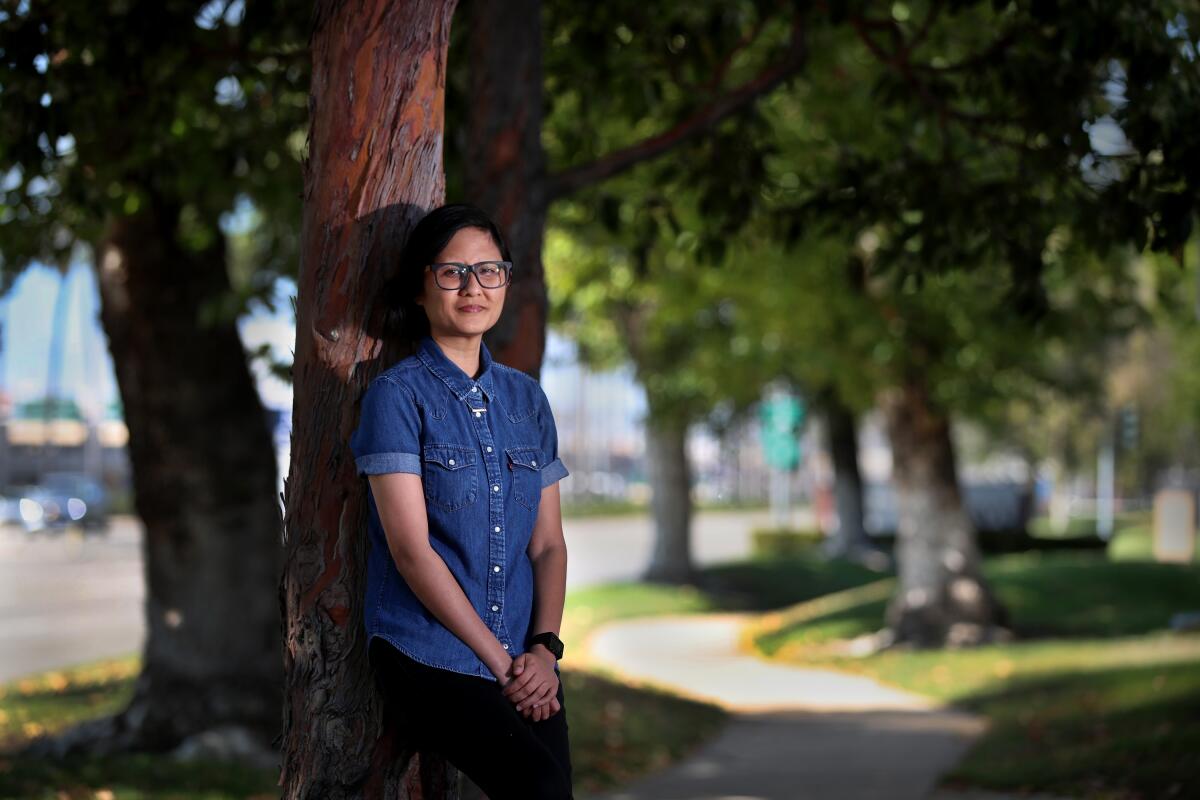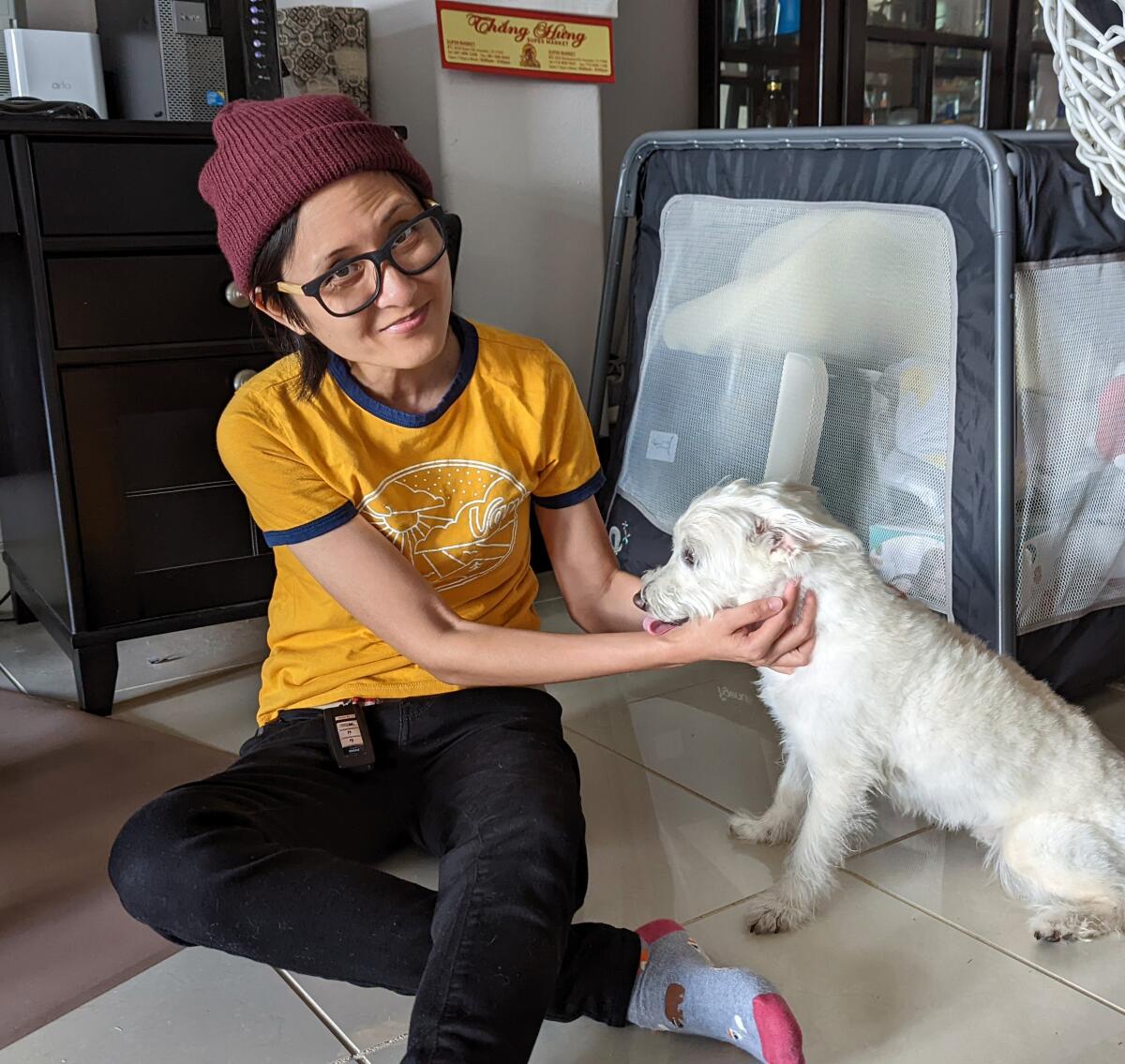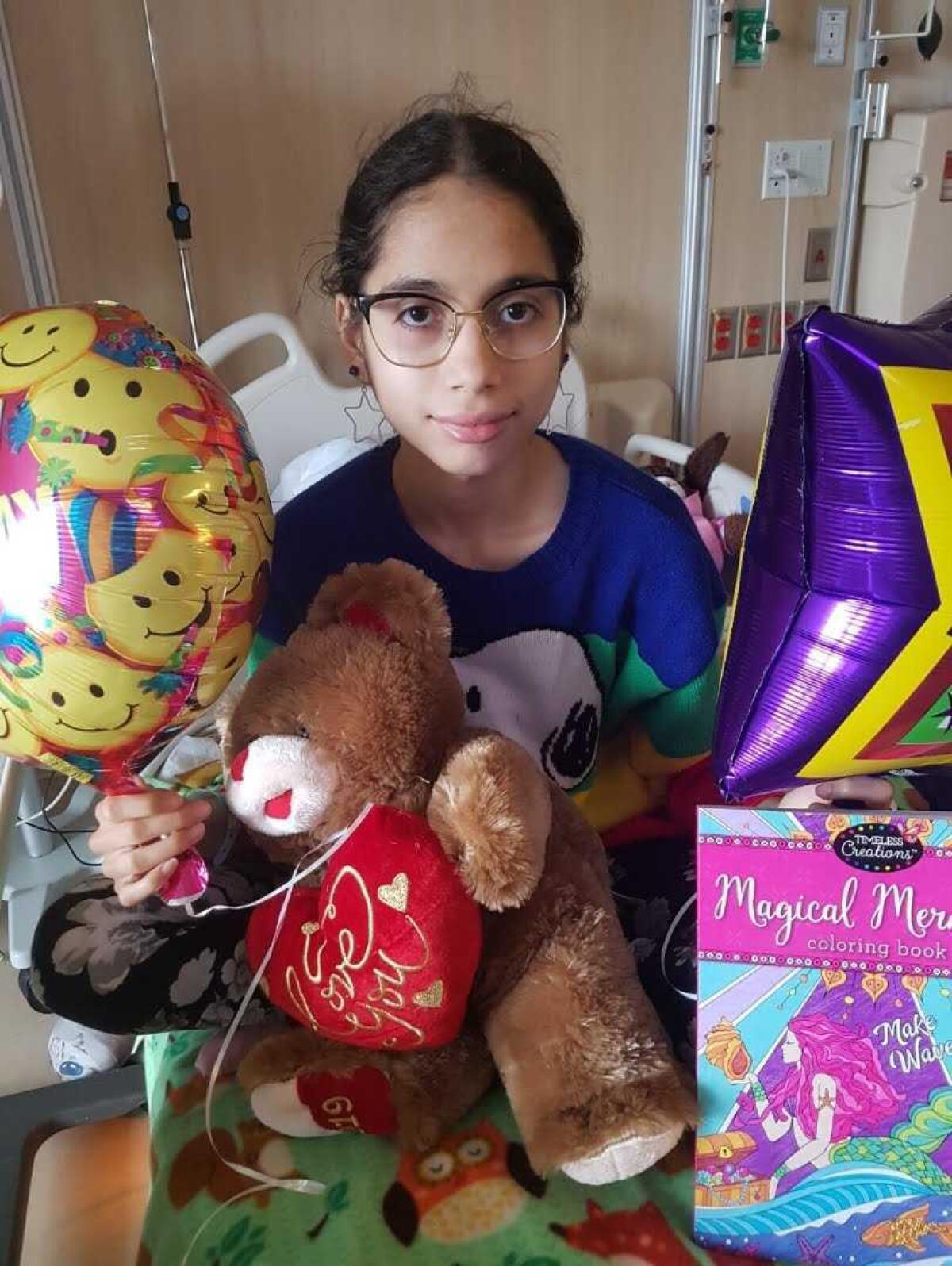A surge in eating disorders in Medi-Cal patients shows stark gaps in care

- Share via
Kim Nguyen weighed barely 80 pounds when she finally reached an eating disorder specialist through Medi-Cal last year.
Her periods were sporadic. Her electrolytes were dangerously skewed, a condition that could lead to coma, seizures or sudden cardiac death. The Orange County resident said she and her new psychiatrist quickly agreed she needed more care. But getting it through the country’s largest public insurance program took almost a year.
“It took me until I was really deep into partial hospitalization to realize that not being hungry is not normal,” said the 36-year-old, referring to a form of full-day outpatient care. “I’m in a much better place now.”
Eating disorders such as Nguyen’s are extremely deadly: Among mental illnesses, only opioid addiction kills more. Yet, while studies show rates of illness are similar across race and class, those with public insurance are two-thirds less likely to be diagnosed and treated than their wealthier peers, according to a 2023 study in the Journal of Eating Disorders.
Now, with cases surging among California’s poorest patients, the state is struggling to reform its Byzantine system for allocating care.

“Back in 2017, we would have five referrals for eating disorders annually,” said Michael Tredinnick, a program manager for the Los Angeles County Department of Mental Health. “Now, we get that in a week.”
The surge began early in the pandemic, amid a deluge of depression, anxiety and drug overdoses. But while those conditions have started to ebb, clinicians say anorexia, bulimia and binge eating disorder are still at their high water mark, an observation bolstered by recent data from the CDC showing ER visits for eating disorders remained up by more than 50% from 2019.
“All of us were holding our breath, hoping that eventually the demand would start to go back down,” said Dr. Erin Accurso, clinical director of the UCSF Eating Disorders Program. “We really haven’t seen that to date.”
The crisis is particularly acute for teenagers, many of whom are hospitalized repeatedly for complications of malnutrition while waiting to be approved for mental health care.
“Kids with eating disorders who have Medi-Cal, they get into this vicious cycle,” Accurso said. “Some of these kids have well over 10 hospitalizations.”
Jennifer Lopez-Avila has been hospitalized 14 times for complications of anorexia over the last five years. Last August, she spent six weeks in the hospital after her weight bottomed out at 79 pounds.
“Since I was 15, I haven’t had my period for more than three months consecutively,” said the Central Valley resident, who at 21 was just diagnosed with osteopenia, a precursor to osteoporosis. “You can burst your esophagus from purging, or your electrolytes can go crazy and it’s the end. I knew my heart could stop.”

Because the effects of starvation are so serious, hospitalizations for eating disorders are longer and many times more expensive than admissions for other mental illnesses such as depression, substance abuse and psychosis, according to a 2014 study in Pediatrics. The mean cost of hospitalization for depression was around $13,000, compared with $46,000 for eating disorders.
Medi-Cal covers those complications just as it would pneumonia or a compound fracture. Yet the care that might stem them — including residential treatment, partial hospitalization or intensive outpatient programs — is increasingly out of reach for roughly half of California children.
“Our wait list at UCSF is the longest it’s ever been,” Accurso said. “We used to run closer to three to six months. Now we’re looking at 12 to 18.”
Experts in Southern California say they’ve been similarly inundated.
“It’s a pretty unprecedented spike, in both the volume and the speed,” said Dr. Stuart Murray, director of the Eating Disorders Program at USC. “We’re not equipped to meet the demand.”
In part, that’s because providers have long failed to recognize eating disorders in nonwhite teenagers — those most likely to use Medi-Cal — until they’re gravely ill.

“The myth that eating disorders only affect middle-to-upper-class white girls continues,” Accurso said. “Even providers who know it’s a myth still engage in that bias when they’re assessing people.”
This myth is mirrored on TikTok, where bony white girls with feeding tubes post about their diagnoses using variations of the hashtag #EdSheeran — a feint for the app’s famously censorious algorithm, where Ed stands in for ED, or eating disorder — while teens of color describe the same pathological behaviors without calling themselves anorexic or bulimic. (Both use the butterfly emoji, a common symbol for recovery.)
“I had a client who said they would throw up whenever they would feel full because they were anxious feeling full, and they had no idea that was unhealthy,” said Naomi Tapia, an Orange County therapist who specializes in eating disorders in Latino patients.
Black and Latino teens are also more likely to struggle with bulimia and binge eating disorder, which can lead to serious cardiac complications and significantly increase suicide risk even in patients who aren’t underweight. Decades of studies show those risks multiply with every hospitalization and each delay in care.
“You really have to advocate that you’re sick enough,” said eating disorder educator Gloria Lucas, a harm reduction activist and recovering bulimic who gets care through the Orange County Health Care Agency. “There’s so much white supremacy even in how eating disorders are perceived and who is allowed to receive adequate help.”
Lucas and others say limiting treatment to patients with a body mass index under 20 is a structural barrier for many patients of color, because that metric was built on actuarial data from white men.
But even as her BMI brushed the lower limit of human survival — the point after which starving people will die no matter what or how much they are fed — Lopez-Avila said her county therapist doubted her diagnosis.
Even when providers are competent, Madera County, where Lopez-Avila lives, is hundreds of miles from most treatment centers. And there’s no privacy for online programs in the cramped home she shares with her parents, 11-year-old brother and two adult siblings.
Worse, most eating disorder specialists are monolingual English speakers, meaning family therapy sessions — the gold standard for anorexia nervosa — are eaten up by an interpreter volleying information back and forth to her parents in Spanish.
“That takes up a lot of time and things get lost in translation,” Lopez-Avila said. “It’s so difficult.”
Experts say transportation, housing and linguistic barriers make recovery that much harder for Medi-Cal patients.
But mostly, the crisis is a function of bureaucracy.
Despite the recent surge in demand, the state Department of Health Care Services doesn’t track how many Medi-Cal patients get treatment for eating disorders or what that care costs. Indeed, there is no single system or set of standards by which publicly insured patients qualify for care, and no uniform method of paying for it, state documents and interviews with county officials show.
Instead, once Medi-Cal patients are physically stable — meaning their heart rate is in the mid-50s instead of the high 30s, or their potassium level is 3.4 milliequivalents per liter instead of 2.5 — their fate falls to one of 58 separate county behavioral health systems, where bureaucrats with little knowledge of eating disorders weigh who deserves care.

“One suggested we weigh ourselves together, and he would be trying to lose weight while I was trying to gain weight,” Lopez-Avila recalled. “When I got my new therapist, I immediately told her I wanted that referral [to specialized care], but I was told I had to be assessed first. I had been to and from the hospital three times by then.”
Indeed, the process of reaching so-called “higher level” care is so obscure, complex and protracted, only a fraction of qualified patients get through it. Even healthcare and insurance administrators struggle to understand how it works.
“With Medi-Cal, hospitals don’t know where to send folks,” said Alexa Grayson, an insurance navigator with the national nonprofit Project HEAL, who helped both Nguyen and Lopez-Avila get care. “When people get to me, they’re at the end of their rope.”
Rather than join the wait list for a residential or intensive outpatient program directly from the hospital, as many privately insured patients do, Medi-Cal patients often must first undergo rounds of new lab tests and fresh psychiatric evaluations through the county — a process each county does differently.
This first step takes weeks. In the interim, many become too ill to attend the program they’ve applied for. Others get a little bit too well.
“If you progress too quickly, they kick you out,” said Lucas, the educator.
Lopez-Avila agreed.
“I was afraid if I did start making progress while I was waiting for treatment ... they would [decide] I didn’t need to go,” she said. “That drove me further into my eating disorder, because I have to prove myself, or I won’t get what I need.”
For those who remain just sick enough, the question becomes how care should be paid for.
In Los Angeles and much of the rest of Southern California, the county negotiates a “single case agreement” — a one-time exception to insurance “in-network” rules — with an individual provider for each patient it deems eligible.
In Santa Clara and many Northern California counties, by contrast, the behavioral health department inks an “all case agreement” with a set group of providers, and funnels qualified patients to those programs.
“Even those [counties] that are really proactive, it’s terribly challenging,” Accurso said. “Kids that might have been served really well in outpatient care don’t get access soon enough and really deteriorate.”
After her six-week hospitalization at the end of last summer, Lopez-Avila got a single-case agreement for residential care through Madera County Behavioral Health Services. It was her fourth such stay, and the first one the county had agreed should be followed by a step-down program, she said.
For privately insured patients, moving from hospital to residential treatment to outpatient care is like climbing down concrete stairs. The steps may be steep in cost and short in length, but they don’t shift underfoot.
Conversely, for many Medi-Cal patients, those stairs are more like a fraying rope ladder. For close to two months after she was discharged from residential treatment last winter, Lopez-Avila said she dangled without care, arriving at the partial hospitalization program 25 pounds underweight — too far behind to graduate to the less-supportive intensive outpatient program in the time Madera County had agreed to fund.
By spring, she was back in residential treatment. Today, she’s in a partial hospitalization program in Carlsbad, 400 miles from her family, with no sense of when she might be well enough to go home.
“If they’d been quicker to get me into partial hospitalization, I could have avoided starting over,” she said.
Experts say streamlining payment could speed that process, as it has for addiction treatment. Last year, the Department of Health Care Services went so far as to direct Medi-Cal programs to split the cost of eating disorder treatment with county mental health departments.
But the plan, like the patients, has languished, without details of how such cost-sharing should work.
Despite bureaucratic barriers, California remains one of the few states where patients with public insurance can get eating disorder care at all.
“California has been the best state to work with,” said Grayson, the insurance navigator. “I love when somebody comes to me with Medi-Cal, because I’m like, ‘OK, there’s hope.’”
But here too, hope often curdles into despair.
“It gets kind of hopeless, because you know it’s in reach, there’s a way to get there, but people aren’t doing enough to help you,” Lopez-Avila said. “It felt like these people don’t want to help, they don’t believe me. It felt like no one was even trying.”
Over time, despair can turn deadly.
Medi-Cal patients “only get help when they’re sent to the hospital because they pass out or they’ve attempted suicide,” said Tapia, the Orange County therapist. “They have to wait until it’s extreme in order to be seen, and once it’s no longer extreme, they’re sent home and the cycle continues.”
Indeed, a 2011 meta-analysis in the Archives of General Psychiatry showed 1 in 5 deaths from anorexia is suicide, a risk that increases the longer a patient is sick and the more severe their illness.
“It’s something that surprises parents,” Accurso said. “These kids may be doing really well in school, they may be doing really well socially. It’s hard to reconcile that with someone being so ill and so medically and psychologically at risk.”
For Lucas, the statistics are a call to arms. She has spent years fighting for eating disorder harm reduction, a model that aims to modify dangerous behaviors without pushing patients to renounce them. In practice, this can mean teaching protective dental care to use alongside purges, or “negotiating” meal plans to stabilize weight instead of increasing it.
“They focus on putting people in treatment, but the majority of us will never set foot in these treatment centers,” the educator said. “We know the high level of suicide in eating disorders, why would we not welcome as many interventions and community-based models as possible?”
More to Read
Sign up for Essential California
The most important California stories and recommendations in your inbox every morning.
You may occasionally receive promotional content from the Los Angeles Times.










